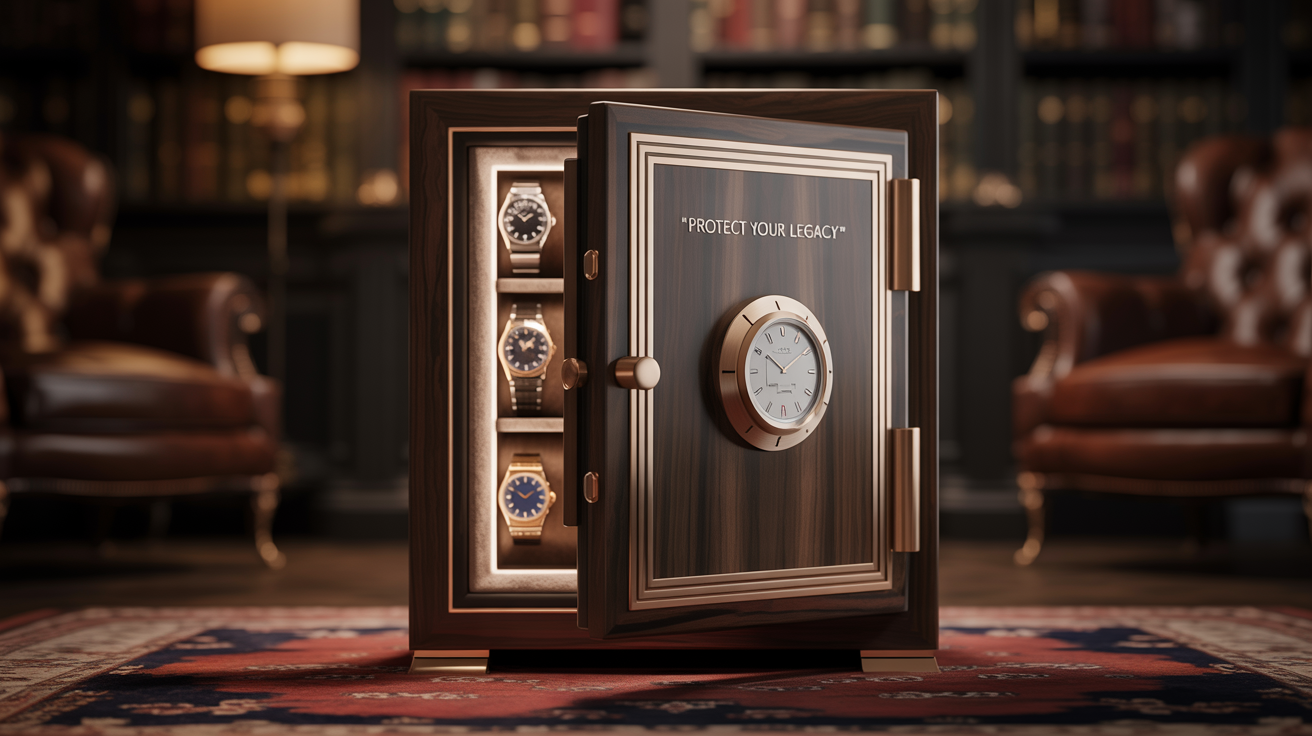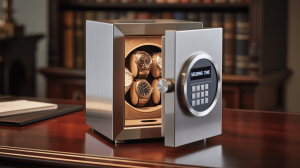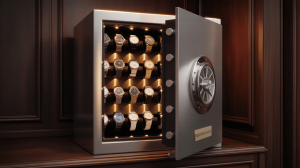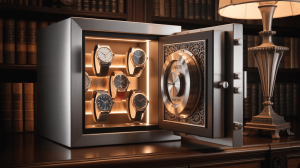Top 5 Features to Look for in a Safe with Watch Winder. But here’s the kicker… Merging robust security with precise winding requires careful selection. A quality safe–winder hybrid protects your watches from theft and fire while keeping them running seamlessly.
1. Certified Security and Fire Rating
A true hybrid safe meets industry standards for both burglary and fire. Look for UL RSC (Residential Security Container) or equivalent burglary ratings and UL 72 fire ratings of 30–60 minutes at 1,200–1,400 °F. Reinforced steel walls, pry‑resistant doors, and expandable gaskets provide peace of mind.
| Certification | Protection Type | Rating Range |
|---|---|---|
| UL RSC | Burglary resistance | Attack time up to 5 minutes |
| UL 72 (Class 350) | Fire resistance | 30–60 min @ 1,200–1,400 °F |
2. Integrated Programmable Winder Mechanism
Your safe’s winder must offer adjustable turns‑per‑day (TPD) and directional control (CW, CCW, bi‑directional). Customizable TPD avoids over‑ or under‑winding. High‑quality, low‑vibration motors (< 25 dB) ensure quiet operation and mechanical longevity.
3. Secure Electrical and Backup Power Options
Reliable power prevents winding interruptions. Seek dual power support: AC adapters for continuous use and rechargeable battery packs for backup. Low‑battery alerts and a manual key override or mechanical dial ensure uninterrupted access.
4. Interior Organization and Protection
Inside, your safe should protect each watch and accessory. Modular foam inserts and velvet‑lined cushions cradle cases; removable trays convert winder slots to storage. Dedicated pockets for straps and tools keep everything tidy.
| Component | Purpose | Advantage |
|---|---|---|
| Foam Inserts | Holds watches securely | Prevents movement |
| Removable Trays | Switch between winder/storage | Flexible configuration |
| Accessory Pockets | Store straps and tools | Keeps extras organized |
5. Smart Monitoring and App Integration
Modern hybrid safes pair via Bluetooth or Wi‑Fi to send tamper, door‑open, and low‑battery alerts. Smartphone apps let you adjust TPD, rotation direction, and view audit logs—bringing remote peace of mind.
6. Lock Type and Access Speed
Choose between electronic keypads, biometric scanners, or mechanical locks. Electronic locks offer multiple user codes; biometrics grant quick fingerprint access; mechanical keys never fail without power. Dual‑lock setups combine methods for redundancy.
7. Build Quality and Materials
The safe’s exterior material affects both aesthetics and security. Powder‑coated steel resists corrosion; aluminum alloys reduce weight; luxury models use leather or wood veneers. Internally, high‑density foam and anti‑scratch linings safeguard finishes.
| Material | Durability | Style |
|---|---|---|
| Powder‑coated Steel | High impact resistance | Matte or gloss finishes |
| Aluminum Alloy | Lightweight, corrosion‑resistant | Modern metallic look |
| Wood Veneer/Leather | Decorative, scratch resistant | Premium aesthetic |
8. Noise Level and Vibration Control
Even the best winder is distracting if loud. Look for motors rated under 25 dB and rubber‑damped mounts that absorb vibration. Quiet operation ensures your safe fits in bedrooms or offices without disturbance.
9. Size, Capacity, and Modularity
Compact units hold 1–4 watches; larger cabinets accommodate 5–8 plus accessories. Modular interiors let you add or remove winder modules, watch pillows, or gun/rifle racks in dual‑purpose models.
10. Installation and Anchoring
A top‑grade safe should include anchor kits for bolting to floors, walls, or furniture. Proper installation prevents thieves from carrying the entire unit away.
| Installation Method | Security Boost | Tools Needed |
|---|---|---|
| Floor Mounting | High | Drill, anchors |
| Wall Mounting | High | Brackets, screws |
| Furniture Integration | Very High | Mounting kit |
11. Maintenance and Support
Regular upkeep extends lifespan. Monthly dusting, quarterly lock tests, and annual motor checks prevent failures. Choose brands with strong warranties and responsive customer support for repairs or part replacements.
12. Price vs. Value Considerations
Hybrid safes range from $300 to $2,000+. Entry‑level models offer basic winding and security; mid‑range units add fire resistance and smart features; premium options include luxury finishes and app integration.
| Price Tier | Core Features | Ideal User |
|---|---|---|
| $300–$600 | Basic security + winder | Casual collectors |
| $600–$1,200 | Fire rating + smart alerts | Enthusiasts |
| $1,200+ | Luxury finishes + biometric | High‑end collectors |
13. Warranty and Longevity
Check for multi‑year warranties covering both safe and winder components. A 2–5 year warranty indicates manufacturer confidence. Extended service plans or onsite support add convenience.
14. Aesthetic and Custom Options
Personalize your safe with custom finishes, engravings, or interior color choices. Some brands offer tailored sizes or branded logos—perfect for gift giving or matching décor.
| Custom Feature | Availability | Cost Impact |
|---|---|---|
| Engraving/Logo | Select models/custom orders | +10–15% |
| Color Matching | Limited palettes | +5–10% |
| Interior Trim Options | Leather, suede, foam colors | +5–10% |
15. Conclusion: Secure Winding in One Solution
Selecting a safe with integrated watch winding means you never compromise on protection or performance. Ready for the good part? Prioritize certified security, programmable winding, reliable power, thoughtful organization, and smart monitoring to keep your collection safe and running flawlessly.
FAQ
Q1: Do all safes with winders include fire protection?
Not always—verify UL fire ratings before purchase.
Q2: How many TPD should I set?
Follow your watchmaker’s recommendation, typically 650–1,800 TPD.
Q3: Can I use solar power for winding?
Some models offer solar trickle charging but depend on light exposure.
Q4: Is maintenance complicated?
Basic upkeep—dusting and lock tests—is straightforward; full motor checks annually recommended.
Q5: Are smart features necessary?
Optional, but app alerts and remote controls enhance convenience and security.







